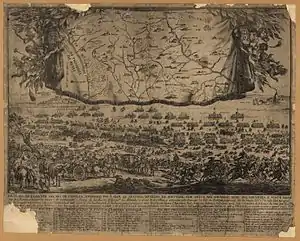| Battle of Ameixial | |||||||
|---|---|---|---|---|---|---|---|
| Part of Portuguese Restoration War | |||||||
 17th-century Portuguese engraving depicting the Battle of Ameixial | |||||||
| |||||||
| Belligerents | |||||||
|
|
| ||||||
| Commanders and leaders | |||||||
|
|
| ||||||
| Strength | |||||||
|
17,000 (3,000 from British Isles):[3][4]
|
| ||||||
| Casualties and losses | |||||||
|
More than 1,000 Portuguese killed 100 English casualties |
4,000 killed All the artillery captured[3] | ||||||
The Battle of Ameixial, was fought on 8 June 1663, near the village of Santa Vitória do Ameixial, some 10 kilometres (6.2 mi) north-west of Estremoz, between Spanish and Portuguese as part of the Portuguese Restoration War. In Spain, the battle is better known as the Battle of Estremoz.
%252C_1673-1675_-_Feliciano_de_Almeida_(Galleria_degli_Uffizi%252C_Florence).png.webp)
Background
In the spring of 1663, the Spanish had undertaken their most successful attack on Portugal, since the beginning of the war.
Under command of John of Austria the Younger, son of Philip IV of Spain (and the conqueror of Catalonia and of the Kingdom of Naples and winner of the French in Italy), the greater part of the south of Portugal was overrun. The important city of Évora was taken on 22 May, opening perspectives for a march on Lisbon, 135 kilometres (84 mi) to the west.
But the lack of ammunition, food and money paralysed the Spanish army. The Portuguese raised a 17,000 men strong army led by Sancho Manoel de Vilhena, aided by Frederick Schomberg, 1st Duke of Schomberg, Fernando de Meneses, Count of Ericeira and other senior officers, and marched against the Spanish.[7] The Spanish commander decided to retreat to a strategic position at the north east of Évora and wait for the enemy, leaving a garrison of 3,700 in Évora.
The Portuguese army was reinforced by three regiments (1 cavalry & 2 infantry) of about 3,000 troops, from England (mostly from around the British isles) which were put under the command of the Duke of Schomberg.[4] Also included were a small number of mercenaries from France. Of this foreign contingent, almost 2,000 English fought in Ameixial, about 1600 incorporated in the infantry and 300 in the cavalry.
Battle
The standard of Don John of Austria was captured when his squadron was almost totally killed.[8] The standard was later presented to King Afonso VI of Portugal himself.[8]
Aftermath
The Spanish casualties were very high, all of their artillery and baggage was captured,[3][8] and the army was forced to retreat to Badajoz in Extremadura. When the Spanish garrison of Évora of 3,700 men capitulated on 24 June 1663, the whole expedition was a complete failure. The independence of the Kingdom of Portugal was saved while the military career of John of Austria ended.
A memorial stone was placed on the site of the battlefield.[9]
The battle is memorialized in a prominent azulejo of the Room of the Battles (Sala das Batalhas) in the Palace of the Marquises of Fronteira, created in 1671–1672.[10]
See also
References
- ↑ Dauril Alden, p. 115
- ↑ Edward McMurdo, p. 421
- 1 2 3 Edward McMurdo, p. 420
- 1 2 Paul, Hardacre (1960). The English Contingent in Portugal, 1662–1668,. Journal of the Society for Army Historical Research, volume 38. pp. 112–125.
- ↑ H. V. Livermore, p. 188
- ↑ Ribeiro, p. 91
- ↑ Rui Natário, As Grandes Batalhas da História de Portugal, Marcador Editora, Barcarena, 2013 (in Portuguese)
- 1 2 3 The Manuscripts of J. M. Heathcote, pp. 111–112
- ↑ H. V. Livermore, p. 169
- ↑ The inscription in Portuguese reads as follows: Altissimo enseaimaimportante memoravel batalha Domingial q’ ganharão asenvensiveis armas portuguezas asitidas da direcção do Conde Devillaflor eosmais cabos e pessoas notaveis [damaged section] em seus ostos aonumeroso vetereno easis formidavel exercito deCastela que governava Dom ião de Austria oprimeiro Castelhano que por suas virtudes fama nasimento heomais natural filho de Felippe 4 idisputada econseguida aos 8 deiunho de 663 com total rota detodo o exercito eperda universal do trem de bagagens eartilharia epessoas degrande conta e grandes deespanha e dous mil cavallos q’ se tomarão vivos for a os mortos eferidos que ficarão no campo. Nuno Lemos Pires (2000). "Os painéis de azulejos da Sala das batalhas do Palácio Fronteira de um ponto de vista militar". Academia.edu.
Bibliography
- Livermore, H. V (2004). Portugal: A Traveller's History. Boydell Press. ISBN 978-1843830634.
- McMurdo, Edward (2010). The History of Portugal – From the Reign of D. Joao II. to the Reign of D. Joao V. – Volume III. Read Books Design. ISBN 978-1444695694.
- Ribeiro, Ângelo (2004). História de Portugal: A Restauração da Independência – O início da Dinastia de Bragança. ISBN 989-554-110-4.
- The Manuscripts of J. M. Heathcote, Esq., Conington Castle. H. M. Stationery Office. 1899.
- Alden, Dauril (1996). The Making of an Enterprise: The Society of Jesus in Portugal, Its Empire, and Beyond, 1540–1750. Stanford University Press. ISBN 978-0804722711.